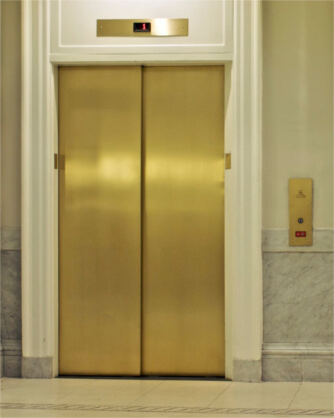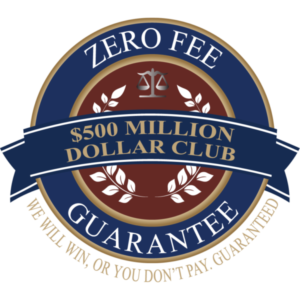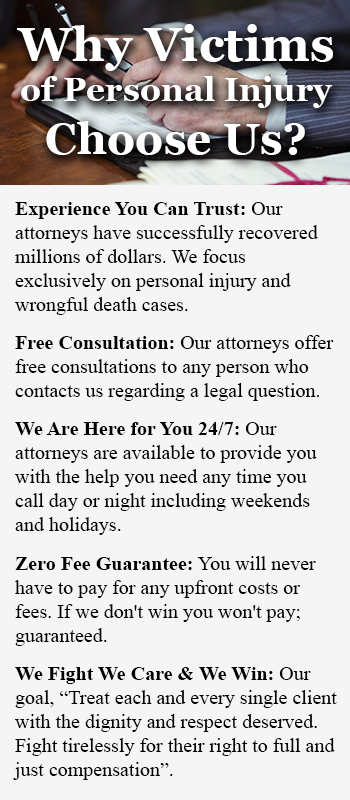 If you or a loved one has been injured at any building as the result of an elevator accident you may be eligible for significant financial compensation. In the event of an elevator accident, the building owners, elevator maintenance, or elevator manufacturer could be held liable for damages. At the top-rated Normandie Law Firm, our skilled Los Angeles elevator accident attorneys can assist you in suing the hotel, building, or property owner responsible for your damages. If you have any questions after reading this article, please feel free to contact our law firm for a free consultation with an expert lawyer experienced in elevator injury cases.
If you or a loved one has been injured at any building as the result of an elevator accident you may be eligible for significant financial compensation. In the event of an elevator accident, the building owners, elevator maintenance, or elevator manufacturer could be held liable for damages. At the top-rated Normandie Law Firm, our skilled Los Angeles elevator accident attorneys can assist you in suing the hotel, building, or property owner responsible for your damages. If you have any questions after reading this article, please feel free to contact our law firm for a free consultation with an expert lawyer experienced in elevator injury cases.
Elevator Accidents
Suffering from an elevator accident can often be a terrifying and traumatizing experience. Elevator accidents are a common occurrence; according to the U.S Bureau of Labor Statistics and the Consumer Product Safety Commission, roughly 17,000 people are injured and 30 people are killed every year from elevator accidents. There are an estimated 900,000 elevators in the US alone, making the odds relatively high for an elevator accident to occur. There are five main types of elevators, and they are categorized in size and capacity:
- Passenger: Hydraulics or tractions can drive passenger elevators. The hydraulic variety offers a maximum travel height of 50 feet, while traction-driven elevators can surpass that as they often operate in medium and high rise buildings.
- Freight: Freight elevators are a more durable variety of elevator and are used to carry heavy loads such as general lifting freight, carrying motor vehicles, and loading industrial trucks.
- LULA: LULA stands for “Limited Use/Limited Application.” This form of elevator is used by a small number of people and is used on a light, as-needed basis. They are often designed to fit into small spaces.
- Home: Home elevators are used for the convenience or accessibility within the home. Home elevators are commonly used in the homes of those who have limited mobility.
- Personnel: Personnel elevators are used on as an as-needed basis by maintenance, mechanical, or operations personnel. They are often installed in places like power plants, dams, and underground facilities.
Elevators are often tested and built to last, but mistakes can happen. While sometimes these errors are to be expected, others can occur at the fault of a responsible party. In the event that an accident occurs at the fault of a responsible party, that party may be expected to pay for the damages. Some common elevator mistakes are as follows:
- Faulty doors, which can cause an open shaft exposing passengers to the risk of falling
- A malfunction in the pulley system, or a mechanical breakdown or defect that causes an elevator to drop rapidly within the shaft
- Faulty wiring, or elevator control malfunction
- Asphyxiation from being trapped inside an elevator for too long
- Incomplete repairs, maintenance, or inspections
- Wiring faults or entrapment due to the heat from fire or water from emergency sprinklers or hoses
- Unbalanced leveling and the failure of lining up the elevator correctly with the floor, leading to trip and fall accidents while leaving the floor.
These are just some of the possible faults that can occur in an elevator. If you have suffered injuries from any of these, or any similar accidents your damages may be compensated. Depending on the specific aspects of your elevator accident, many parties could be found liable for the damages. For example, if your accident occurred in a service elevator due to a lack of proper maintenance, the maintenance team could be deemed responsible for the damages. Or if the accident was caused by a failure to uphold proper maintenance routines within an office building or hotel, that office building and hotel could be held liable for failing to properly maintain their elevator. Regardless of the details of your specific elevator accident injury, it is always in your best interest to retain the assistance of a skilled attorney who has experience handling elevator injury claims.
Our Recent Verdicts and Settlements
$500,000
$599,000
$1.5 Million
$600,000
$525,000
$250,000
One of the Most Common Elevator Incidents
Sudden stops and sudden drops are among the most common types of elevator accidents. An abrupt stop or a sudden start (drop) can cause those inside the elevator cart to be jolted aggressively. Although there are rails in elevators that passengers can hold onto, there is no way to know when sudden stops and starts will occur, so passengers cannot just hold on to lessen the jolting. When there is a sudden stop or sudden drop, passengers can be thrown around the elevator cart. They can crash into walls or into other passengers in the cart and fall onto the floor, for instance.
Sudden stops and sudden starts can lead to a number of injuries, some of which could potentially include the following: head injuries and traumatic brain injuries; neck injuries; back injuries; shoulder injuries; spinal cord injuries; hip injuries; knee injuries; broken bones; sprains and strains; lacerations. If you or a member of your family suffered harm in a sudden stop or sudden drop elevator accident, do not hesitate to seek legal assistance with the experts at our law firm immediately. Our lawyers are ready to provide you with the guidance that I need to pursue your claim and fight for your right to win.
Your Case
 When clients come to our top law firm requesting assistance for their elevator accident injury, they often ask a wide range of questions regarding uneven elevator injury. Below are some of those commonly asked questions:
When clients come to our top law firm requesting assistance for their elevator accident injury, they often ask a wide range of questions regarding uneven elevator injury. Below are some of those commonly asked questions:
- Can I sue a hotel for injuries due to accidents because the elevator stopped uneven?
- Can I sue an office building for the elevator stopping uneven and injuring me?
- Can I sue a mall or property owner if the elevator stopped higher than the floor and I got injured?
- Can I sue a mall if the elevator stopped lower than the floor and I fell?
Essentially, what seems to be a reoccurring theme among some of our clients is questions regarding elevator trip and fall accidents. Elevator trip and fall accidents can, most commonly, occur when an elevator stops unevenly at a floor, or level. They can occur at hotels, malls, stores, or any property wherein an elevator is required for transport. In these cases, a qualified attorney who has experience in elevator injury cases can assist with determining the best course of action for your uneven elevator lawsuit.
In regards to these commonly asked client questions, yes, you can sue a hotel, office building, mall, or property owner for damages in the event that you tripped and fell as the result of a uneven elevator. However, in order to file a successful case, you must be able to prove that the property owner acted negligently, and that those negligent actions resulted in your damages. Listed below are the required elements that a plaintiff must show a court, in order to prove negligence:
- Duty: The plaintiff (passenger) must be able to show that the defendant (property owner) owed a legal duty to the plaintiff under the circumstances.
- Breach: The plaintiff must show that the defendant breached their legal duty by acting or failing to act in a certain way.
- Causation: The plaintiff must show that the defendant’s actions (or lack thereof) caused the plaintiff’s injury
- Damages: The plaintiff must show that they were harmed or injured as a result of the defendant’s actions (inactions). This can be typically done through the presentation of medical bills and the evidence of lost wages.
In order to file a successful lawsuit it is important to contact the authorities and a lawyer right after the elevator accident. This is done to preserve the evidence at the scene and discuss the legal rights that are owed to you. Once the appropriate parties have been contacted, it is recommended that you take an accurate inspection of the elevator, the components, and the elevator’s control room. In the unfortunate event that the accident resulted in death, it is recommended that you seek experts to thoroughly investigate the scene. Some of these experts include: a fire rescue or evacuation expert, a professional building management expert, and an elevator safety expert.
It is recommended that you have an accomplished attorney with expertise in elevator injury lawsuits thoroughly examine your elevator uneven with the floor lawsuit, in order to determine whether or not it would be more viable to file a defective product claim or a claim of negligence. For this reason, having an experienced attorney on your side is crucial to filing a successful claim.
¡Hablamos español!
Nuestros abogados de accidentes de elevadores están listos para evaluar su caso y ayudarle a someter una demanda por las lesiones que sufrió. No importa en donde ocurrió su accidente de elevador – puede que usted tenga el derecho a demandar por sus lesiones. En Normandie Law Firm, nuestros abogados tienen décadas de experiencia con todo tipo de caso de lesiones y lo pueden ayudar. Estamos listos para proveerle la representación legal que usted necesita y pelear por su derecho a una recompensa justa por sus lesiones.
About Our Los Angeles Law Firm
Having one of our attorneys with experience in elevator injury cases on your side can mean the difference between filing a successful claim for compensation, and having your case thrown out of court. At Normandie Law Firm our team of elevator uneven with the floor trip and fall lawyers is committed to ensuring that you receive the compensation you deserve for the damages you have endured. Our firm practices in Santa Monica, Beverly Hills, Hollywood, and the rest of the Los Angeles area. Under our zero fee guarantee policy all of our clients only pay for our services once their case is won. Every one of our clients is also offered a free consultation as well as free second case reviews. Reach out to our law offices today, and we can get you one step closer to resolving your case. Call us today to talk with one of our experienced lawyers.












